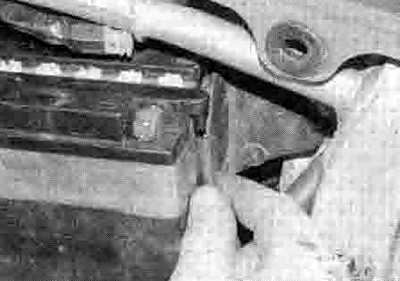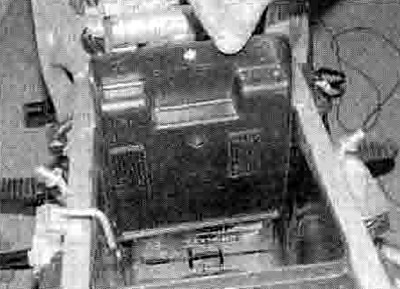Caution: Be extremely careful when handling or working around the battery. The electrolyte is very caustic and an explosive gas (hydrogen) is given off when the battery is charging.
Removal and installation
XL600V and XRV750-L to N (1990 to 1992) models
1. Make sure the ignition is switched OFF. Remove the right-hand side panel (see Chapter 8).
2. Unscrew the negative (-) terminal bolt first and disconnect the lead from the battery (see illustration). Lift up the red insulating cover to access the positive (+) terminal, then unscrew the bolt and disconnect the lead (see illustration).

3.2a. Disconnect the negative lead first...

3.2b ...then lift the terminal cover and disconnect the positive lead
3. Unscrew the two battery retaining bracket bolts and remove the bracket, noting how it fits (see illustrations). Disconnect the breather tube from its union (see illustration). Draw the battery away from the bike and remove it (see illustration).

3.3a. Unscrew the bolts...

3.3b ...and remove the bracket

3.3c. Disconnect the breather tube

3.3d. Draw the battery out...

3.3e ...and remove it
4. On installation, make sure the battery bracket is correctly fitted and secure. Clean the battery terminals and lead ends with a wire brush or knife and emery paper. Do not forget to connect the breather tube to its union. When reconnecting the leads, connecting the positive (+) terminal first.
Battery corrosion can be kept to a minimum by applying a layer of petroleum jelly to the terminals after the cables have been connected. There are also dedicated sprays commercially available.
5. Install the side panel (see Chapter 8).
XL650V models
6. Make sure the ignition Is switched OFF, Remove the right-hand side panel (see Chapter 8).
7. Unscrew the battery negative (-) terminal bolt first and disconnect the lead from the battery. Disconnect the starter relay wiring connector (see illustration). Lift up the red insulating cover to access the battery positive (+) terminal, then unscrew the bolt and disconnect the lead.

3.7. Starter relay (A) and its wiring connector (B)
8. Displace the starter relay assembly from its holder on the battery retaining bracket (see illustration 3.7). Unscrew the nut securing the bracket at the top, then lift it to release the tabs from the slots in the battery box. Remove the battery from the bike.
9. On installation, make sure the battery bracket is correctly fitted and secure. Clean the battery terminals and lead ends with a wire brush or knife and emery paper. When reconnecting the leads, connect the positive (+) terminal first. Connect the starter relay wiring connector after the battery negative (-) terminal.
Battery corrosion can be kept to a minimum by applying a layer of petroleum jelly to the terminals after the cables have been connected. There are also dedicated sprays commercially available.
10. Install the side panel (see Chapter 8).
XRV750-P models onward (1993-on)
11. Make sure the ignition Is switched OFF. Remove the seat (see Chapter 8).
12. Release the tool kit strap and remove it. Unscrew the bolt securing the battery cover and remove the cover, noting how its tabs on the bottom locate (see illustration).

3.12a. Unscrew the bolt (arrowed)...

3.12b ...and remove the cover
13. Unscrew the negative (-) terminal bolt first and disconnect the lead from the battery (see illustration). Lift up the red insulating cover to access the positive (+) terminal, then unscrew the bolt and disconnect the lead. Slide the battery out of its box, then tilt it slightly towards the rear of the bike so that you can your hand on it and lift it out.

3.13. Unscrew the negative (-) lead (A) first, then the positive (+) lead (B)
14. On installation, clean the battery terminals and lead ends with a wire brush or knife and emery paper. Reconnect the leads, connecting the positive (+) terminal first. Make sure the cover locates correctly and is secure.
Battery corrosion can be kept to a minimum by applying a layer of petroleum jelly to the terminals after the cables have been connected. There are also dedicated sprays commercially available.
15. Install the seat (see Chapter 8).
Inspection and maintenance
16. Refer to Chapter 1 for scheduled maintenance. The following checks should also be regularly performed.
17. Check the battery terminals and leads for tightness and corrosion. If corrosion is evident, undo the terminal bolts and disconnect the leads from the battery, disconnecting the negative (-) terminal first, and clean the terminals and lead ends with a wire brush or knife and emery paper. Reconnect the leads, connecting the negative (-) terminal last, and apply a thin coat of petroleum jelly or dielectric grease to the connections to slow further corrosion.
18. Keep the battery case clean to prevent current leakage, which can discharge the battery over a period of time (especially when it sits unused). Wash the outside of the case with a solution of baking soda and water. Rinse the battery thoroughly, then dry it.
19. Look for cracks in the case and replace the battery with a new one if any are found. If acid has been spilled on the frame or battery box, neutralise it with a baking soda and water solution, dry it thoroughly, then touch up any damaged paint.
20. If the motorcycle sits unused for long periods of time, disconnect the cables, negative (-) terminal first. Refer to Section 4 and charge the battery once every month to six weeks.
21. Check the condition of I he battery by measuring the voltage present at the battery terminals. Connect the voltmeter positive (+) probe to the battery positive (+) terminal, and the negative (-) probe to the battery negative (-) terminal. When fully charged there should be 13.0 to 13.2 volts present. If the voltage falls below 12.3 volts the battery must be removed, disconnecting the negative (-) terminal first, and recharged as described below in Section 4.
